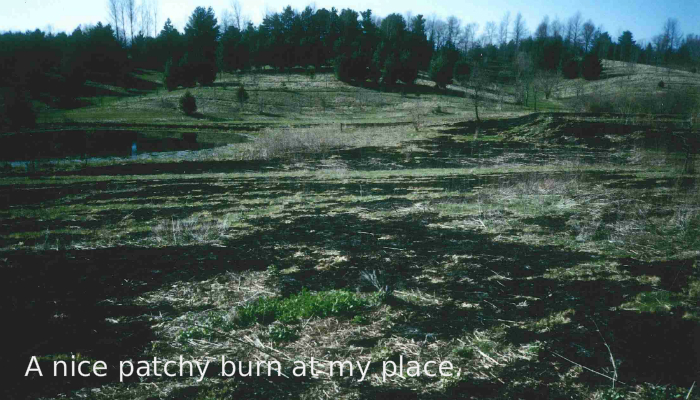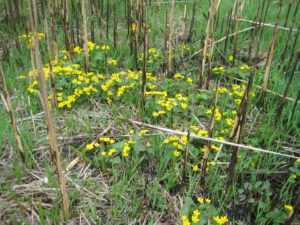Why We Burn, What We Burn, When We Burn, How We Burn

Folks who burn native landscapes should review their goals and methods, because nature is an ever-changing dynamic. Finding a new butterfly or salamander on a property can shift our role dramatically.
One reason to burn part of a landscape is for fire protection. A grassland recently burned becomes a firebreak for the rest of that fire season (see Our Neighborhood Blackline/Blueline Firebreak). Regular burning of woodlands keeps fuel loads small, something the US Forest Service did not understand for a century, and now our western forests go up in enormous conflagrations – which destroy everything down to the mineral soil – and are totally unmanageable. One of my students who worked for them said that a western forest fire was something the government threw money at until rainstorms put it out.
Another reason to burn is that here on the edge of the prairie, fire was an integral part of the whole ecosystem and all the components are well adapted to it. Most prairie plants are deep-rooted perennials, and dormant season fire benefits them when the old thatch is burned off. This turns the landscape into a dark solar collector, which warms up quickly, and the ash leaches its nutrients – like potassium – back into the soil with the first rain. The landscape then quickly greens up with the first mild days of late winter or early spring. Native Indians also burned near their villages to attract deer, elk, and bison to within their hunting territories.
Our average annual 32 inches of rain locally is adequate to support forest all over the landscape, and the only reason prairie was, and is, here is that fire, grazing, (and today herbicides), plus occasional drought, kills or suppresses trees and shrubs.
Eastern Iowa is gradually losing oak from unmanaged woodlands because oak needs sun and the canopy openings they thrived in were often created by fire. Today oak is being replaced by the more shade-tolerant – and fire intolerant – maple and basswood. Likewise, wetlands become overgrown with cattails or phragmites, especially if overfertilized, and will choke out shorter species unless fires comes to their rescue.

Marsh marigold blooming a week after burning the cattails.
Fire is a predator and like any predator affects each species in different ways. Deer will flee a roaring grass fire, with good reason. But as a low oak leaf fire creeps through a woodland, they will daintily jump over it to get to the other side. The smaller creatures like mice and frogs are more vulnerable, and timing becomes more important to them. In early March the cold-blooded hibernators like snakes, turtles, and most frogs are still safely below ground, and as spring unfolds they gradually appear, so later spring burns are more likely to harm them. By late April or early May, the grassland birds are starting to nest, another good reason to not postpone your burn.
It is our native insects who are really vulnerable to burns because many of them overwinter as eggs, pupae, or adults on vegetation or in the ground litter. Dennis Schlict, lead author of The Butterflies of Iowa, has for decades pointed out that rare butterfly species have persisted for more than a century on tiny relict prairie patches, only to vanish once someone introduces a burning program. One method to avoid destroying all of them on a property is to do rotational burns of different portions in different years. The dividing boundaries should be laid out to split small habitats so only part of each upland, valley bottom, wetland, hillcrest, etc. gets burned in any particular year. There is no agreement about how frequently the rotation should be done, because many other factors come into play, such as invasives needing control, the need for fire protection, availability of assistance, the county burning ban, etc. In general, newly planted prairie is very weedy and needs annual burning, while a prairie remnant often has an established sod of native plants, which are more resistant to invasion and might get by just fine on a ten-year cycle or an irregular cycle.
My own preference for preserving insect and small critter populations is the patchy burn. I find this is usually best done by burning in the early evening as the day is cooling, the wind has died down, and the dew is settling. Then the fire usually does not burn very thoroughly nor very hot, but rather wanders more slowly around and through the flammables, leaving many patches unburned or only scorched on top. This is easily controlled and sometimes I manage the whole fire by myself. The year following a patchy burn, last year’s unburned areas now have two years’ worth of fuel accumulation and preferentially burns to create another patchy burn if I can catch similar conditions again.
So when you are responsible for a fire, think through your goals, including how the animals will respond, and factor that into how you burn and when you burn – and even if you burn.


